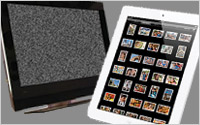 According to ethnographic research by Strategy Analytics on a small focus group of multiscreen users, the viewers studied were significantly distracted from the first
screen by their mobile phones and tablets.
According to ethnographic research by Strategy Analytics on a small focus group of multiscreen users, the viewers studied were significantly distracted from the first
screen by their mobile phones and tablets.
The study of behaviors finds that among the people engaged on that second screen, they were particularly inattentive to the TV during commercial
breaks. The Strategy Analytics Digital Home Observatory did in-depth ethnographic studies of a dozen multiscreen viewers in typical TV situations.
The findings -- although preliminary and
observational rather than quantitative on a limited sample -- suggest that the level of user distraction by the second screen varies across content types. For instance, the researchers found that
high-impact TV scenes did succeed in pulling the user’s attention to the TV and away from devices.
But the ad spots tend to be a cue for users to focus on the device. This supports
observations Yahoo made around mobile search behaviors earlier this year. The company found that 55% of daily mobile Internet use occurred in the home, and as much as 86% of people with mobile
phones used them in front of a TV. During the Oscars telecast this year, Yahoo Mobile saw its traffic and engagement rise 12% during commercial breaks.
According to the report
“Multi-Screen User Behaviors in the Home,” mobile use in the living room may have a substantial effect on the ways in which users experience television. Reflecting on the study of users,
Strategy Analytics Senior Analyst and study author Caroline Park says: “Multiscreen users very rarely concentrate solely on a television show in its entirety, and while this presents
challenges to the TV industry, it also offers new opportunities for viewer engagement.”
A number of mobile offerings are trying to recapture distracted users with apps that actually
focus the viewer on the show. Social networking apps like GetGlue and Yahoo’s recently acquired IntoNow attempt to weave exchanges among fans on the mobile platform back into the TV screen
experience.
Several cable and network providers are crafting apps that enhance the on-screen experience with chats, as well as supplementary material. BravoTV, ABC and others have
experimented with this second screening approach. Usually, these efforts are attempts to extend the experience of the first screen onto the second. But given Strategy Analytics’ preliminary
findings, TV programmers may consider second-screen efforts as necessary platforms to retrieve and focus users.
The small sampling from the U.S. and UK during August is far from definitive
and more directional for future research. As Park says, programmers will need to explore when and how the user focus shifts from different kinds of programming to devices if they hope to retain the
user’s attention --especially during ad breaks.
Interestingly, there is also a TV effect on mobile tastes. Park finds that users liked casual mobile games where the game play fit
neatly into ad breaks. They wanted games that could be stopped quickly and easily when the show came on.